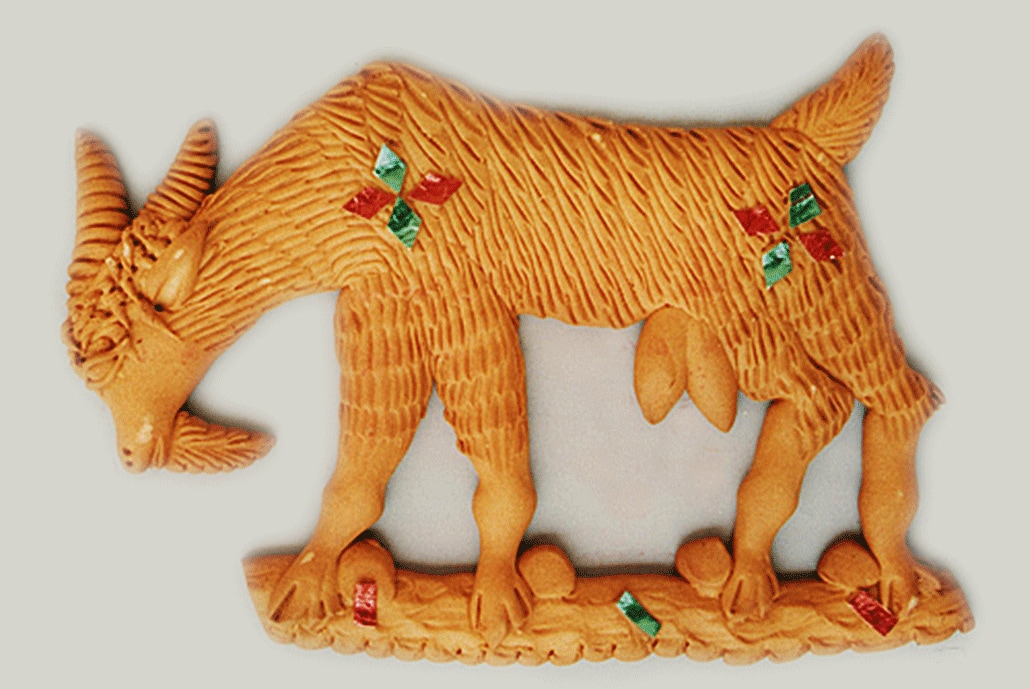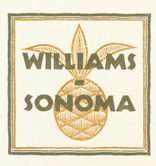|
Here in our home, one of our Christmas traditions is making gingerbread cookies and one gingerbread house each year. (CLICK to see one of our creations.) I often wondered if there is something similar in Italy and in fact, I discovered something very similar to gingerbread made in Campania, Calabria, Sicily and most of southern Italy: the Mostaccioli, a shaped, spiced, and unleavened hard cookie. Depending on the recipe, they may contain wine must (leftover from the wine making process), red wine or honey. Mostaccioli are not only for Christmas, but also for Easter and other sagre and religious festivals. With its roots deep in Italian history, perhaps from the time of the Romans when they were placed on temple alters as offerings to the Roman gods, the tradition of Mostaccioli was continued by 15th century Dominican monks. These shaped, edible works of art are very hard and long-lasting--just like gingerbread. 
You might see Mostaccioli under other names in local dialects throughout Southern Italy: Mastazzola, Mustazzoli, Mastazzuolu, 'Nzuddha, Mustazzuali, Mustazzolus (in Sardinia). Those dialects in the south can change from village to village! Regardless of the name, this spice cookie is considered by most historians to be the oldest cookie recipe in the world.
The name comes from the Latin mustacea, a cake made out of “must” (un-fermented, pressed grapes, including skins, seeds and stems) that has been made since at least 300 BC. In the 1st century AD, the ancient Roman philosopher, Cato, wrote about mustacea being made with rye flour, cheese, cumin, anise, cheese, eggs and wrapped in bay leaves. Modern recipes are very different from 2000 years ago, but Mostaccioli have been made throughout central and southern Italy for hundreds of years--maybe more. The recipes for creating the most intricate shapes contain no leavening and create a dough that can be shaped by sculpting tools or pressed into molds.
While most versions contain honey, others might contain chocolate, but in all cases they are very spicy, similar to a spice cookie or gingerbread. There are simpler, non-sculpted Mostaccioli, in either a round or diamond shape, that are covered with a chocolate icing, which are more common--especially with home bakers. Some may even contain various nuts like almonds, hazelnuts or pignoli and might be shaped into a traditional biscotti shape. One version in Puglia even adds a special ingredient: a sweet wine with sugar added that has been reduced over heat into a syrup... adding a hint of the cookie's ancient past when grape must was used.
CLICK HERE for a Ciao Italia recipe.
(NOTE: There are also recipes for a pasta called Mostaccioli, typically in a penne shape.)
Food historians tend to agree that the current recipe gained popularity in 1653 after Saint Domenico--the patron saint of the Kingdom of Naples--distributed Mostaccioli cookies after a devastating earthquake in Sariano, Calabria. Every since then, on August 16th (my birthday and the Feast Day of St. Domenico), people in Calabria celebrate by baking Mostaccioli cookies and auctioning them off to benefit charity.
The traditional shapes hearken back to temple offerings: a parma (the palm), a sirena (the siren), u panaru (the basket), u pisci spada (swordfish), and a grasta (the heart)... all real items that historically might have been left as an alter offering. The other shapes--saints, goats, roosters, horses, pigs, lambs and birds--reflect Roman Catholic holidays and the desire to please children around the holidays. Besides Christmas, Mostaccioli are also given as gifts at Easter, weddings and on special saint days. The intricate shapes are made even more decorative by the addition of colored foil "jewels". Some of these cookies have been elevated to a fine art form and were the subject of a special exhibit at National Museum of Applied Arts in Rome with 36 ancient shapes being displayed.
During both Natale (Christmas) and Pasqua (Easter) and other saint Festa and harvest Sagre celebrations, you will often see Mostazzolari (vendors) selling their cookies at throughout Italy, but especially in the South. Many display their cookies in a traditional manner--in wooden treasure chests. After all, these do resemble precious bejeweled treasures.

Recipe for traditional Mostaccioli for Molding or Shaping
The Preparation is straightforward and simple..... it takes only three ingredients... Equal weights of flour and honey: 16 ounces of 00 Italian flour, or all-purpose flour 16 ounces honey 1 tablespoon lard (or shortening) 1/2 cup of either: grape must, Anisette, Sweet Marsala or white grape juice
A more traditional method: You can prepare the dough using one part water and three parts honey, heated in a double boiler while sifting flour slowly until a dough is formed. Let the resulting dough rest, covered overnight and then knead by hand.
--Jerry Finzi
Watch this video to see these Masters of the craft sculpt their Mostaccioli...
Copyright 2017, Jerry Finzi/Grand Voyage Italy - All Rights Reserved
|
Archives
May 2024
Categories
All
|









